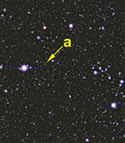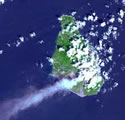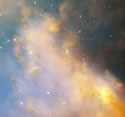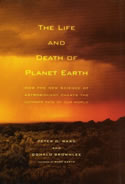
Image credit: Subaru Telescope
The Subaru telescope, based in Japan, has detected the most distant galaxy ever recorded at 12.8 billion light-years away. The Subaru Deep Field project team uncovered 70 candidate distant objects, by using a special filter which only allows light of a very specific wavelength to pass through – one that corresponds to objects which are approximately 13 billion light-years away.
Subaru telescope has found a galaxy 12.8 billion light years away (a redshift of 6.58; see note 1), the most distant galaxy ever observed. This discovery is the first result from the Subaru Deep Field Project, a research project of the Subaru Telescope of the National Astronomical Observatory of Japan which operates the Subaru telescope. The Subaru Deep Field (SDF) project team found approximately 70 distant galaxy candidates by attaching a special filter designed to detect galaxies around 13 billion light years away on a camera with a wide field of view. Follow-up observations with a spectrograph confirmed that two out of nine of the candidates are in fact distant galaxies. One of these is the most distant galaxy ever observed. This discovery raises the expectation that the project will be able to find a large number of distant galaxies that will help unravel the early history of the universe in a statistically meaningful manner.
The SDF project is an observatory project of the National Astronomical Observatory of Japan designed to showcase the abilities of Subaru telescope and to resolve fundamental astronomical questions that are difficult to address through Subaru’s regular time allocation system. Most research programs on Subaru telescope are selected through a competitive time allocation process called Open Use, which is open to all astronomers but allows a maximum of only three observing nights every six months. By pooling together observing nights reserved for the observatory and astronomers that contributed to the establishment of Subaru Telescope, an observatory project can address questions that require greater telescope resources than the typical research proposal. The SDF project’s main goal is to detect a large number of the most distant galaxies detectable and to understand their properties and their impact on the evolution of the universe. The speed of light is the fundamental limit to how fast information can travel (see note 2). When we detect light from a galaxy 13 billion light years away, that means we are seeing the galaxy as it was 13 billion years ago. Looking for ever more distant galaxies means looking at galaxies at earlier and earlier times in the universe.
The SDF observations took advantage of the fact that light from distant galaxies have a characteristic wavelength and shape. Astronomers think that the earliest galaxies rapidly formed stars from hydrogen, the dominant form of matter in the universe. The light from these stars would have excited any hydrogen remaining around them to higher energy states and even ionize it. When excited hydrogen returns to lower energy states, it emits light at several distinct wavelengths. However, most of this light would escape the young galaxy as an emission line at 122 nanometers because “bluer” light with shorter wavelengths and higher energy can re-excite other hydrogen atoms. Since the universe is expanding, the farther away a galaxy is from us, the faster it is moving away from us. Because of this movement, light from distant galaxies are doppler shifted to longer, or redder wavelengths, and this emission line is “redshifted” to a longer wavelength that is characteristic of the galaxy’s distance and the galaxy itself appears redder. As the light travels the long distance from its origin to Earth, light at the higher energy side, or blue side of the emission line, can be absorbed by the neutral hydrogen in intergalactic space. This absorption gives the emission line a distinctive asymmetrical look. A overall red appearance and a strong emission line at a particular wavelength with a particular asymmetrical shape is the signature of a distant new born galaxy.
To detect the most distant galaxies ever observed, the SDF team developed a special filter that only passes light with the narrow wavelength range of 908 to 938 nanometers. These wavelengths correspond to the 122 nanometer emission line after travelling a distance of 13 billion light years. The team installed the special filter, and two other filters at shorter and longer wavelengths bracketing the special filter, on Subaru telescope’s Suprime-Cam, Subaru Prime Focus Camera, and carried out an extensive observing program from April through May 2002. Suprime-Cam has the capability of imaging an area of the sky as large as the full moon in one exposure, a unique capability among instruments on 8-m class and larger telescopes, and is extremely well suited for surveys of very faint objects over large areas of the sky. By observing an area of the sky the size of the moon for up to 5.8 hours in each filter, the team was able to detect over 50,000 objects, including many extremely faint galaxies. By selecting galaxies that were bright only in the special filter and preferentially red, the team found 70 candidates for galaxies at a redshift of 6.6 (or a distance of 13 billion light years; see figure 1).
In June 2002, the team used FOCAS, the Faint Object Camera and Spectrograph on Subaru telescope, to observe 9 of the 70 candidates, and confirmed the generally red appearance and an emission line with a distinctive asymmetry in 2 objects (see figure 2), and determined that their redshifts are 6.58 and 6.54. The light from these galaxies was emitted 12.8 billion years ago when the universe was only 900 million years old. The previously observed most distant galaxy, with a redshift of 6.56, was discovered by looking at a large cluster of galaxies that can amplify light from more distant galaxies with a gravitational lensing effect. (See our press release from May 2002, http://www.naoj.org/Latestnews/200205/UH/index.html.)The SDF observations is the first time multiple galaxies at such a great distance have been observed, and without the help of gravitational lensing. The galaxy with a redshift of 6.58 is the most distant galaxy ever observed.
The SDF team expects to find many more distant galaxies through continued observations. Before the first stars and galaxies formed, the universe was in a stage that Astronomers call “the dark ages of the universe”. Determining when the dark ages ended is one of the most important astronomical questions of our time. Core members of the team, Keiichi Kodaira from the Graduate University of Advanced Studies in Japan, Nobunari Kashikawa from the National Astronomical Observatory of Japan, and Yoshiaki Taniguchi from Tohoku University hope that by detecting a statistically significant number of distant galaxies, they can begin to characterize the galaxies that heralded the end of the universe’s dark ages.
Original Source: Subaru News Release




